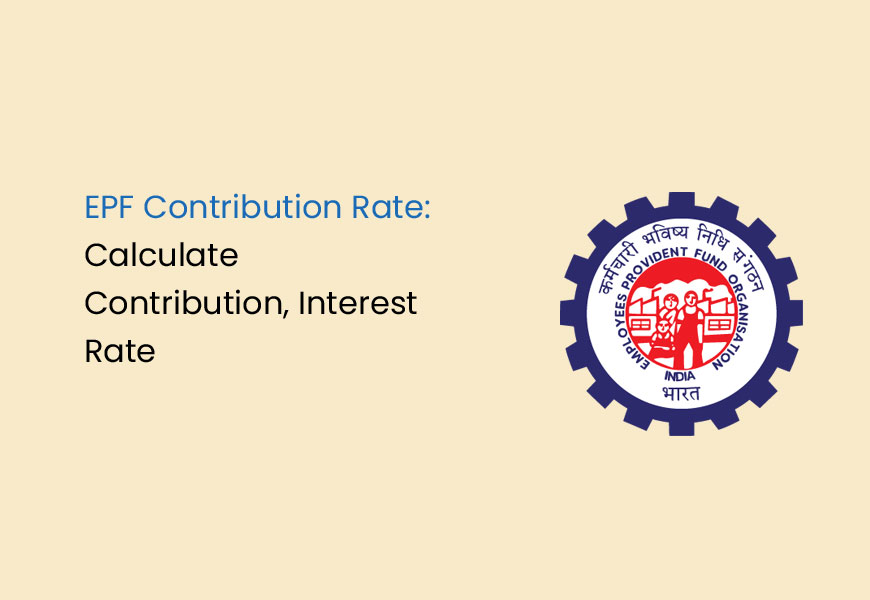The Employee Provident Fund (EPF) is a retirement savings scheme governed by the Employees Provident Fund & Miscellaneous Provisions Act of 1952. It is applicable to employed individuals. Under this scheme, a portion of the employee’s salary is deducted by the employer and deposited into the employee’s EPF account. Additionally, the employer also contributes to this fund.
Upon retirement, the employee receives a lump sum amount from the EPF, which includes the contributions made by both the employee and the employer, along with the interest that’s been accrued annually. The interest rates on EPF accounts are periodically monitored by the government. For the financial year 2022-23, the notified interest rate is 8.15%.
In the Union Budget 2023, a significant change was made regarding the taxation of EPF withdrawals. The Tax Deducted at Source (TDS) rate has been reduced from 30% to 20% for individuals who withdraw EPF funds and do not possess a Permanent Account Number (PAN).
This means that if you withdraw money from your EPF account and you don’t have a PAN card, a 20% TDS will be deducted from the taxable portion of your withdrawal. This move aims to simplify the tax process for EPF withdrawals while ensuring compliance with tax regulations.
This article shall talk about the EPF contribution rate for this, amongst other important details that will help you have a better understanding of the topic and your finances.
Who is Eligible for EPF?
All salaried employees residing in India are required to participate in the Employee Provident Fund scheme from their first day of employment. Once an employee becomes a member, they are entitled to provident fund benefits, as well as insurance and pension benefits.
Registering for EPF is mandatory for all working professionals earning Rs. 15,000 or less. Both the employer and employee have to contribute towards the scheme. However, people earning over Rs. 15,000 can also register voluntarily for the same.
Another important point to note is that once you are a member of the EPF scheme, you will always be a member. This is because of the unique 12–digit Universal Account Number (UAN) that’s assigned to all enrolled under the scheme.
For employers overseeing organisations with 20 or more employees, it is obligatory to register under the EPF scheme. Even if your organisation employs fewer than 20 people, you have the option to voluntarily register under this scheme, amplifying the financial safety net for your employees. As far as the employer’s contribution is concerned; it is divided: 8.33% goes to the Employees’ Pension Scheme, and 3.67% is allocated to the Employees’ Provident Fund. These contributions are regularly updated in the EPF member passbook.
Read More: How to Check EPF Balance Online?
Benefits of EPF for Employees and Employers
EPF Benefits For Employees
- Capital Growth: EPF ensures capital appreciation by providing a predetermined interest rate on the deposits made with EPF India. At maturity, additional rewards enhance the growth of employees’ funds, fostering capital appreciation.
- Retirement Savings: Approximately 8.5% of the employer’s contribution is allocated to the Employee Pension Scheme. Over time, the funds deposited in the employee provident fund build a substantial retirement corpus. This corpus provides financial security and independence during retirement, ensuring a comfortable post-employment life.
- Emergency Fund: Life is unpredictable, and being financially prepared for unforeseen circumstances is crucial. EPF serves as an emergency corpus, allowing individuals to access funds swiftly in times of need. This financial safety net aids in dealing with unexpected expenses, providing peace of mind.
- Tax Benefits: Employees benefit from tax exemptions under Section 80C of the Indian Income Tax Act for their contributions to the PF account. Additionally, earnings generated through EPFO schemes are tax-free, offering significant savings. This exemption can be utilised up to a limit of Rs. 1.5 lakh, reducing the overall tax liability for employees.
- Flexible Withdrawals: EPF members have the flexibility of partial withdrawal. This allows individuals to access funds from their PF account for specific purposes such as higher education, home construction, wedding expenses, or medical treatments. The ease of accessing funds ensures that employees can address various life needs without unnecessary financial stress.
EPF Benefits For Employers
Providing insurance and retirement benefits through schemes like EPF lets employers demonstrate genuine concern for the well-being of their employees and their families. These initiatives are particularly crucial for employees with modest incomes, ensuring their future financial stability and fostering a sense of economic security.
The provision of these social security benefits not only nurtures long-term trust between employers and employees but also significantly enhances productivity, overall output, and employee retention rates. The extension of social security benefits such as those offered by EPF aids the creation of an attractive work environment that appeals to skilled professionals, making it easier to attract and retain top talent.
Importance of Understanding EPF Contribution Rates
The EPF contribution rates in India is not just a procedural requirement; it is a fundamental aspect of financial planning for both employers and employees. For employees, comprehending these rates ensures a clear understanding of their long-term savings and retirement benefits. It empowers them to make informed decisions about their financial future, allowing for better financial stability and peace of mind.
For employers, a profound understanding of EPF contribution rates is essential for fostering a positive and compliant work environment. Adhering to these rates not only ensures legal compliance but also showcases the company’s commitment to the well-being of its workforce. This understanding is a testament to the organisation’s professionalism and dedication to fulfilling its financial responsibilities towards its employees.
Moreover, a deep comprehension of EPF contribution rates facilitates effective financial management for both employees and employers. It enables individuals to plan their savings, investments, and expenditures more strategically, fostering a culture of financial responsibility and prudence.
In a professional context, staying well-versed with EPF contribution rates is a mark of expertise and diligence. It demonstrates a commitment to legal and financial compliance, instilling confidence in stakeholders, employees, and regulatory authorities alike.
In summary, understanding EPF contribution rates is not just about numbers and percentages; it embodies a commitment to financial security, responsible corporate citizenship, and a steadfast dedication to fostering a stable and prosperous work environment for all.
EPF Contribution Rate
The EPF Interest Rate for the fiscal year 2022-23 stands at 8.15%, applicable to all deposits made between April 1, 2022, and March 31, 2023.
For employees with a salary up to Rs. 15,000, the contribution rates are as follows:
- Employee Contribution to EPF: 12% of the salary.
- Employer Contribution to EPF: 3.67% of the salary.
- Employer Contribution to EPS: 8.33% of the salary, capped at Rs. 1,250.
If the salary exceeds Rs. 15,000, the employer’s 12% contribution is divided. 8.33% (Rs. 1,250) goes to the EPS account, and the remaining amount is transferred to the EPF account.
EPF Contribution Rate Trends for the Last 15 Years
EPF interest rates have fluctuated a lot over the past year. Let’s quickly review the change;
| Financial Year | Rate of Interest (p.a.) |
|---|---|
| 2022-2023 | 8.15% |
| 2021-2022 | 8.10% |
| 2020-2021 | 8.50% |
| 2019-2020 | 8.50% |
| 2018-2019 | 8.65% |
| 2017-2018 | 8.55% |
| 2016-2017 | 8.65% |
| 2015-2016 | 8.80% |
| 2013-2015 | 8.75% |
| 2012-2013 | 8.50% |
| 2011-2012 | 8.25% |
| 2010-2011 | 9.50% |
| 2005-2006 to 2009-2010 | 8.50% |
How to Calculate EPF Contributions
We shall try to explain this with the help of an example. If an employee’s basic salary + dearness allowance is Rs. 50,000:
- Employee Contribution to EPF: 12% of Rs. 50,000 = Rs. 6,000.
- Employer Contribution to EPF: 3.67% of Rs. 50,000 = Rs. 1,835.
- Employer Contribution to EPS: Rs. 1,250.
In this scenario, since 8.33% of Rs. 50,000 is Rs. 4,165, Rs. 1,250 is allocated to the EPS account, and the remaining Rs. 2,915 is transferred to the EPF account.
Hence, the total balance in the EPF account becomes Rs. 10,750, calculated by adding the employee’s contribution of Rs. 6,000, the employer’s EPF contribution of Rs. 1,835, and the excess contribution of the employer towards EPS, which is Rs. 2,915.
How to Calculate EPF Interest
To calculate the EPF interest, let’s consider an example where the initial EPF contribution is Rs. 10,750.
First Month
- No interest has accrued yet.
- EPF account balance: Rs. 10,750.
Second Month
- EPF contribution: Rs. 10,750.
- Total amount: Rs. 21,500.
- Interest accrued: Rs. 21,500 * 0.679% = Rs. 145.985.
- EPF account balance: Rs. 21,500.
Third Month
- EPF contribution: Rs. 10,750.
- Total amount: Rs. 32,250.
- Interest accrued (on the previous month’s balance): Rs. 32,250 * 0.679% = Rs. 218.997.
- EPF account balance: Rs. 32,250.
This calculation repeats for each month throughout the year. The total EPF balance at the year-end is the sum of employer and employee contributions plus the monthly interest accrued during the year.
Additionally, it’s important to note
- Salary refers to basic salary plus dearness allowance.
- If the entity has less than 20 employees or is a designated entity, a lower contribution of 10% of wages is required.
Furthermore, the closing balance at the end of the first year becomes the opening balance for the second year. EPF interest for the second year is then calculated, considering the carried forward opening balance from the previous year. For precise calculations, an EPF calculator can be utilised.
Factors Affecting EPF Contribution Rate
Employee’s Basic Salary
The cornerstone of EPF contributions lies in an employee’s basic salary. A higher basic salary means larger contributions, leading to a more substantial retirement corpus. This essentially means that the more you earn, the more you save for your future.
EPF Wage Ceiling
The EPF wage ceiling refers to the maximum limit on the monthly salary that is considered for EPF contributions. If your salary surpasses this ceiling, only the amount up to the ceiling is considered for EPF calculations. It’s like a financial boundary that impacts how much you and your employer contribute to your EPF fund.
Employee’s Age
Age plays a significant role in EPF contributions. As employees grow older, their financial responsibilities change. The EPF scheme adjusts contributions according to the age of the employee, ensuring that individuals, especially as they approach retirement, can continue building their savings at a pace that aligns with their life stage and needs.
Changes in Government Regulations
Government regulations are the guiding principles of EPF contributions. Changes in these regulations directly impact how much you and your employer contribute. These regulations are designed to keep the EPF scheme relevant, fair, and beneficial for employees. When these rules change, they influence the contribution rates, ensuring that the EPF scheme stays in tune with the evolving economic landscape.
These factors highlight the adaptability and responsiveness of the EPF system. It’s not just about numbers; it’s about recognising the diverse financial journeys of employees and ensuring that the EPF scheme caters to their unique needs, helping them build a secure and stable future.
Tips for Maximizing EPF Benefits for employees
- Maximise Contributions: Contribute the maximum allowable amount to your EPF account regularly to ensure a substantial corpus at retirement.
- Understand Tax Benefits: Familiarize yourself with tax benefits associated with EPF contributions. Utilise Section 80C to reduce your taxable income.
- Regularly Check Contributions: Periodically verify your monthly EPF contributions to ensure accuracy. Mistakes can be rectified promptly.
- Avoid Premature Withdrawals: Resist the temptation of withdrawing funds for non-essential purposes. Let your EPF corpus grow for long-term financial security.
- Nominate Beneficiaries: Keep your nomination details updated. This ensures a smooth transfer of funds to your loved ones in case of unforeseen events.
Compliance Tips for Employers
- Stay Updated: Regularly update your knowledge of EPF regulations. Compliance rules change, and staying current is crucial to avoid penalties.
- Timely Contributions: Ensure timely and accurate contributions for all eligible employees. Delays can result in fines and legal complications.
- Documentation: Maintain thorough records of EPF transactions and employee details. Complete and accurate paperwork is essential for compliance.
- Employee Awareness: Educate your employees about EPF benefits, contribution rates, and the importance of their own contributions towards their future.
- Regular Audits: Conduct internal audits to ensure compliance. This proactive approach helps in identifying and rectifying issues before they escalate.
Retirement Planning Advice
- Diversify Investments: Don’t rely solely on EPF. Diversify your investments to create a balanced and secure retirement portfolio.
- Emergency Fund: Have a separate emergency fund. Relying solely on retirement funds for emergencies might impact your long-term savings.
- Health Insurance: Invest in a good health insurance plan. Medical expenses during retirement can erode savings significantly.
- Post-Retirement Budgeting: Plan your post-retirement budget carefully. Factor in all expenses and sources of income to maintain a comfortable lifestyle.
- Review Regularly: Regularly review your retirement plan. Life circumstances change, and your plan should adapt to your evolving needs and goals.
Role of EPF in Social Security
The Employee Provident Fund (EPF) plays a pivotal role in enhancing social security for employees in India. Here’s how it contributes significantly to the social security landscape:
- Retirement Security: EPF acts as a robust retirement savings platform. Mandating contributions from both employees and employers helps ensure that every salaried individual has a financial nest egg when they retire. This regular savings mechanism guarantees a steady income post-retirement, bolstering financial security for the elderly population.
- Economic Stability: EPF provides a stable economic foundation for retired employees. With a consistent income flow, retirees can meet their daily needs, and medical expenses, and maintain their standard of living. This economic stability prevents dependence on social welfare systems, allowing retirees to maintain their dignity and independence.
- Insurance and Pension Support: Apart from the provident fund, EPF also offers insurance and pension benefits. The Employee Pension Scheme (EPS) ensures that retired employees receive a regular pension, further augmenting their financial safety net. In cases of disability or untimely demise, EPF provides insurance coverage, offering financial support to the affected families.
- Social Inclusion: EPF is applicable to employees across various sectors and income groups. By extending its reach to a broad spectrum of the workforce, EPF promotes financial inclusion. It ensures that workers from diverse backgrounds have access to social security benefits, fostering a sense of belonging and inclusivity in society.
- Emergency Financial Assistance: EPF functions as an emergency fund. In times of crises, such as medical emergencies or sudden unemployment, employees can withdraw a portion of their EPF savings. This emergency corpus acts as a vital social safety net, helping individuals navigate unforeseen challenges without falling into financial despair.
- Reducing Burden on Social Welfare: Encouraging personal savings and responsibility helps to alleviate the burden on the government for social welfare programs. It empowers individuals to take charge of their financial future, reducing the strain on public resources and ensuring that social welfare services are available to those who need them the most.
In Conclusion
Understanding the nuances of EPF, from its contribution rates to its intricate interest calculations, is not merely a legal obligation but a fundamental aspect of financial wisdom. It empowers individuals to make informed decisions, plan for contingencies, and secure their financial legacy.
Staying informed and compliant is essential. That’s where platforms like TankhaPay step in. TankhaPay doesn’t just simplify ESI calculation and EPF requirements; it transforms the daunting task of compliance into a streamlined, accessible process. With TankhaPay, navigating the complexities of EPF becomes effortless, ensuring that both employers and employees can focus on what truly matters: building a secure and prosperous future. Take the next step with us.
FAQs on EPF Contribution Rate
Is the EPF interest rate consistent, or does it fluctuate?
The government sets the EPF interest rates, which can change periodically. For the financial year 2022-23, the fixed interest rate is 8.15%.
What is the process of crediting interest to EPF subscribers?
The interest, calculated yearly at the government-declared rate (8.15% for 2022-23), is added to your account every month. This compound interest ensures your savings grow steadily.
Do I continue to earn EPF interest even if I'm not contributing?
Yes, even if you don't contribute due to unemployment or being a Non-Resident Indian (NRI), your account will earn interest for up to 3 years.
How long does EPF interest accrue after retirement?
After retirement, you'll continue to receive EPF interest for up to 3 years. If there are no contributions after 3 years, the account becomes inactive and stops earning interest.
What happens if there's a delay in updating EPF interest in my account?
A delay in updating your passbook doesn't cause any financial loss. The interest earned is added to the closing balance of the year and becomes the opening balance for the next year.
Is there a financial loss if I withdraw my EPF balance before interest updates are processed?
No, you won't lose money. When you withdraw your EPF, the due interest will be calculated and added automatically, even if there was a delay in updating your passbook. So, you won't face any financial loss in such a situation.





















